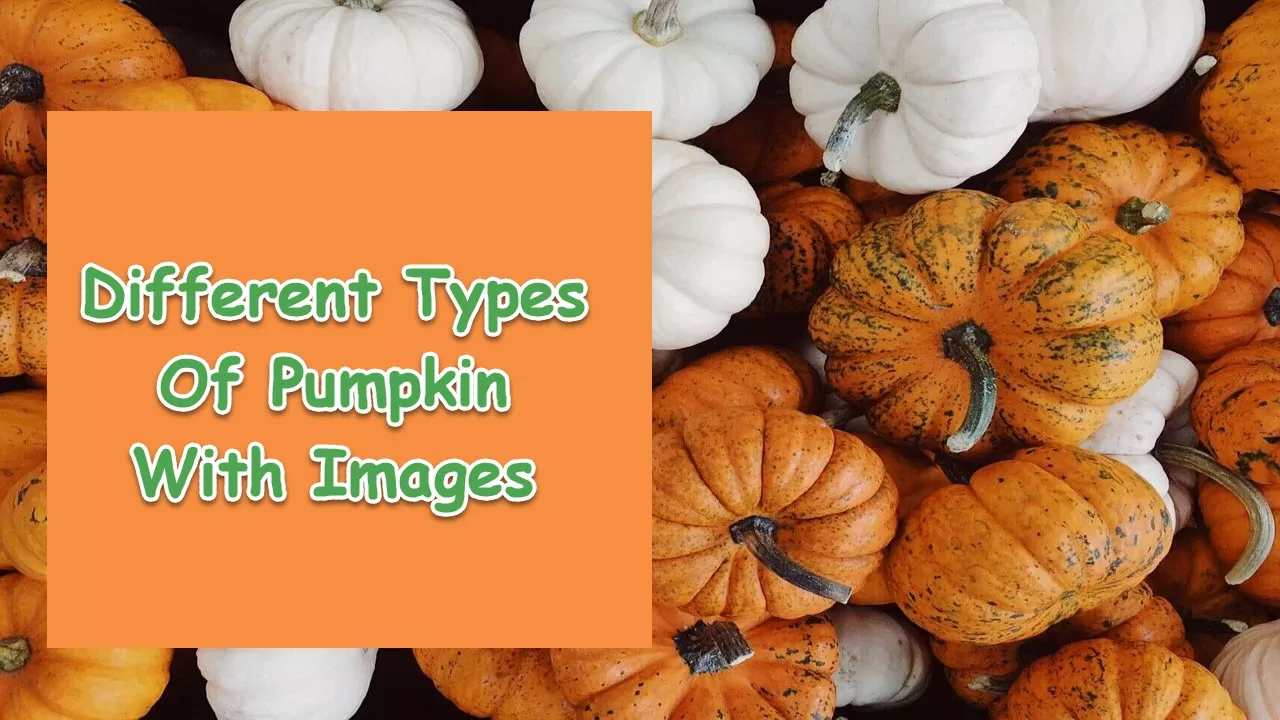Today’s market offers several different types of pumpkins. Pumpkins come in a variety of colors, odd shapes, edible varieties (pumpkin pie), traditional orange pumpkins, and decorative varieties. In this post, learn about the different types of pumpkins.
Scroll down and keep reading if you’re curious what these pumpkin varieties are.
Types Of Pumpkin
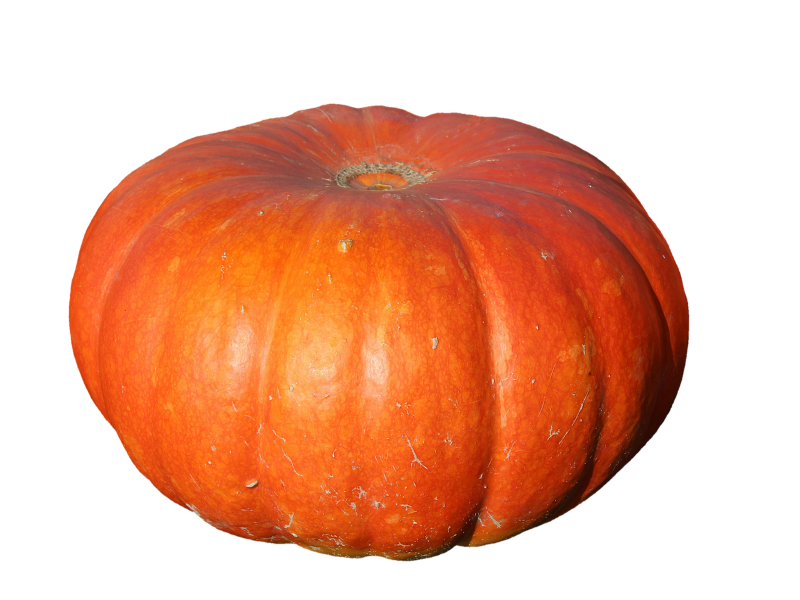
What Is A Pumpkin?
A cultivar of winter squash known as a pumpkin, is a fruit that has a circular shape, smooth, slightly ribbed skin, and is most frequently deep yellow to to bright yellow to bright orange pumpkin in color. The seeds and pulp are enclosed in the thick shell. The name is most frequently applied to varieties of the Cucurbita pepo plant, while several varieties of the Cucurbita maxima, C. argyrosperma and Moschata that resemble pumpkins are also known by this name.
Pumpkins are one of the earliest domesticated plants and are native to North America, particularly to northeastern Mexico and the southern United States. They have been utilized since between 7,000 and 5,500 BC. Growing pumpkins for food, decoration, and amusement is a common practice. For instance, baking pies are a staple of Thanksgiving dinners in both Canada and the United States, and jack-o’-lantern is frequently carved out of pumpkins for Halloween decorations. However, commercially canned pumpkin purée and pumpkin pie fillings are typically made from varieties of winter squash that are different from those used to make jack-o’-lanterns.
The Ancient Greek word “pepon,” which means “melon,” is where the English word “pumpkin” comes from. According to this notion, the term evolved from the Latin peponem and Middle French pompon to the Early Modern English pompion and then was modified to pumpkin by English colonists in the 17th century shortly after coming into contact with pumpkins in what is now the northeastern United States.
The skin of a pumpkin is hard on the outside. The seeds are huge and flat. Pumpkins have yellow, funnel-shaped flowers. Pumpkin fruit is typically a bright orange color. But they come in a range of forms, sizes, and hues.
Pumpkin Species
The largest number of fruit species suitable for human consumption belong to the Cucurbitaceae family. Cucurbita is the most significant member of this family’s species. For instance, the following species have been raised in the New world for a long time. About 1000 species of relatively large and fleshy fruits belong to the Cucurbitaceae family. This family includes squash, watermelons, and cucumbers. Fruits like pumpkins are edible. Depending on the fruit’s maturity, it can have a bitter or sweet flesh.
Cucurbita Pepo
Field pumpkins most frequently come in the Cucurbita pepo variety. In northwest Mexico, it is believed to have started more than 5,000 years ago. It has expanded over six continents.Three subsp. lineages were domesticated during the course of its evolution. Subsp Pepo, subsp fraterna as well as subsp. texana.
This section includes many different pumpkin varieties, both natural and artificial. Mini pumpkins, field pumpkins, decorative gourds, and acorn squash are the most well-known varieties. While the leaves and blossoms can be utilized as vegetables, the fruits and seeds are typically consumed.
Cucurbita Argyrosperma
This group consists of the argyrosperma and sororia subspecies. The ripe flesh is occasionally fed to animals. Typically, their fruits are prepared similarly to vegetables. A basis for sweets can also be made from the flesh of ripe fruit. This kind of fruit’s seeds can be eaten whole, roasted, or pulverized. Many pumpkin soups and stews have the seeds as a key component. On the Yucatan Peninsula, the flesh of these group of fruits is used to cure burns and encourage nursing women to produce more breast milk.
Winter squash and cushaw pumpkin are the two most prevalent types of pumpkin in this group.
Cucurbita Maxima
The origin of this type of pumpkin is South America. They are frequently utilized in cooking. Some members of this species of pumpkin can be utilized as decorations for the home or as ornaments. Turban gourds, giant Hubbards, banana squash, and buttercup squash are included in this group of pumpkins.
Cucurbita Moschata
In Latin America, this particular species of pumpkin was domesticated. The precise origin is not well documented, though. It has been grown for more than 5,000 years. This species’ young, ripe fruits, flowers, and stems are all eaten as vegetables. Sweets can be made from ripe fruits.
This category includes the cultivars giant cheese squash, butternut squash, and crookneck pumpkins.
Check out the different types of pumpkins below.
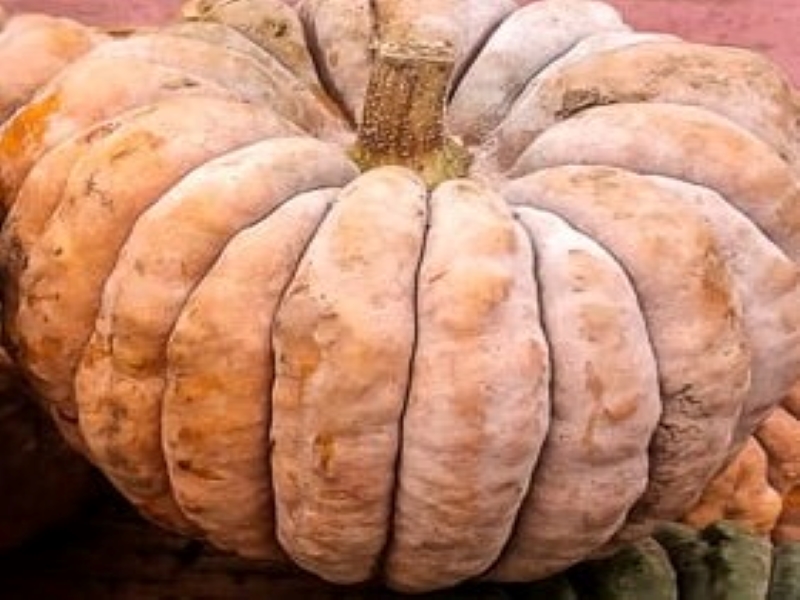
1. Black Futsu
This modest type features a strong green stem, a somewhat oval form, and skin that has a light butternut color.
Its distinct black, warty skin and nutty, fresh flavor make this exotic Japanese delicacy easy to identify. A solid, bright orange flesh with a sweet, buttery flavor when roasted or a delicate, fruity flavor when eaten raw. In winter storage, they mature when the green halo between the flesh and skin vanishes and the skin changes from black to chestnut.

2. Kabocha
Another Japanese variant is the kabocha pumpkin. The flesh is a light yellow than the bright orange of traditional pumpkins, and the it has a dark green skin with yellow flecks. This Japanese pumpkin can be roasted a side dish or puree to make a pumpkin soup.
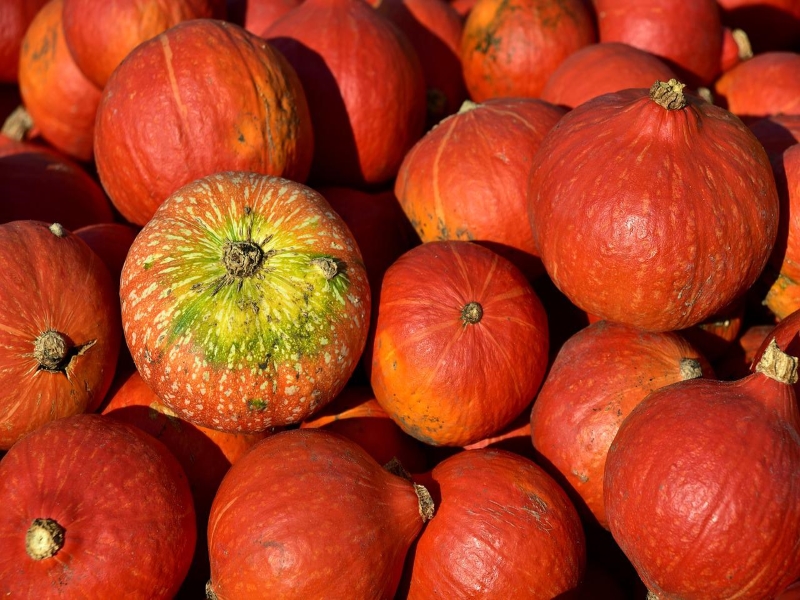
3. Pumpkin Hokkaido
The most delicate of all pumpkin types is this one. As implied by the name, it originates from the Japanese island of Hokkaido. This pumpkin has a sweet flavor that is comparable to potatoes or chestnuts. It is one of the smallest pumpkin varieties ever cultivated. The weight is between 0.7 and 2.5 kg. The hues range from bright yellow to deep orange flesh. Sometimes it appears as white gray or dark green. The flesh is an orange hue. It is fairly well-liked because it has many beneficial impacts on human health.
It contains a lot of vital minerals and vitamins that are good for treating kidney, heart, stomach, spleen, prostate, and pancreatic disorders. Cream soups, jams, marmalades, compotes, and sauces can all be made with this type of pumpkin.
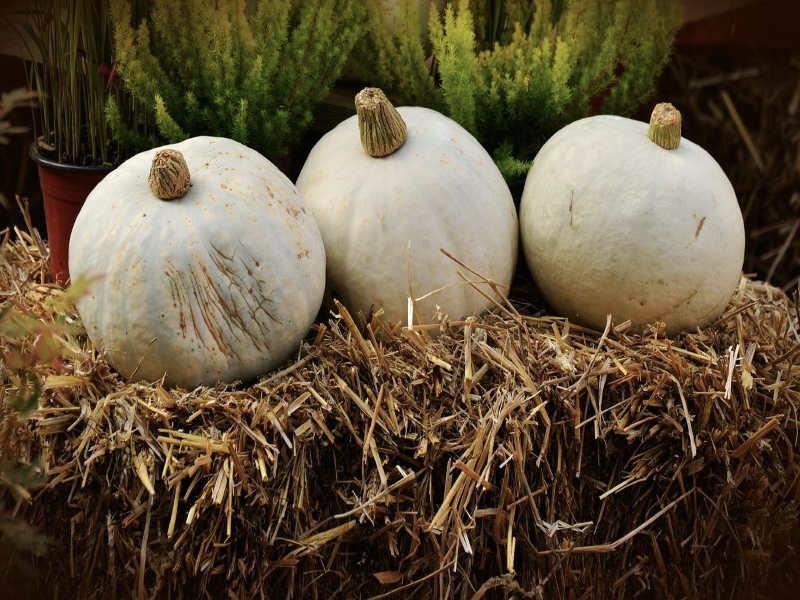
4. Lumina White
This is a white pumpkin type that can weigh up to 12 pounds. They do spoil more quickly than other pumpkin types, despite the fact that they can be excellent in dishes. Therefore, prepare this white pumpkin immediately and avoid making it as an ornament on your porch.
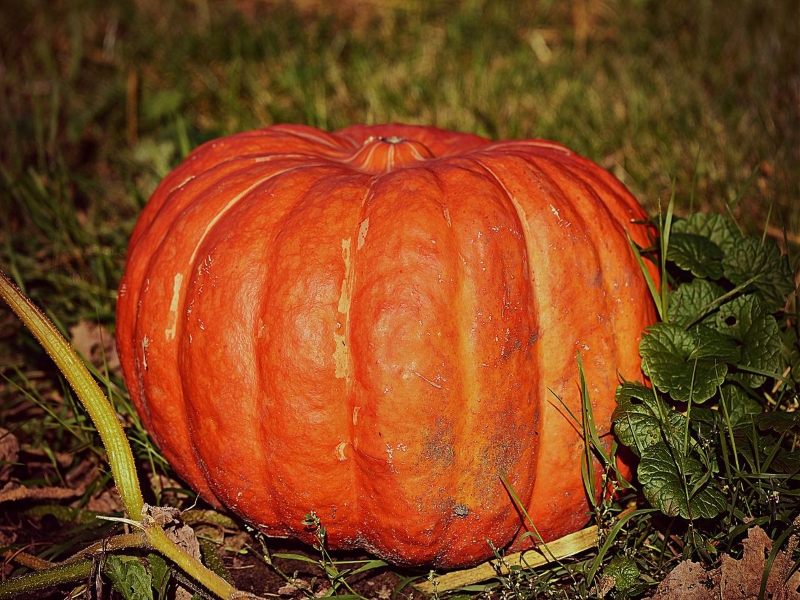
5. Cinderella Pumpkin
This pumpkin has the name of Cinderella’s pumpkin carriage. Despite being on the larger side, in reality, Cinderella pumpkin has a somewhat flattened shape. These huge pumpkins occasionally have a reddish-orange or dark orange flesh. Though not quite as squished as the flat white, they are nonetheless wider than tall. Savory dishes are where this particular pumpkin variety tastes best.

6. Sugar Pie Pumpkin
Sugar pie pumpkins resemble your carved Jack O’ Lanterns but are smaller versions. Their smaller size makes them perfect for a variety of cooking tasks, including roasting and pureeing to produce pumpkin pies and soups. This miniature pumpkin can be used to prepare both savory and sweet foods when cooked.

7. Baby Boo Pumpkin
A white-colored pumpkin known as Baby Boo is both good for cooking and for eating raw. It’s a tasty fluted pumpkin.
When making a festive or seasonal display with lots of contrasting color, this pumpkin is ideal. This pumpkin’s color won’t be easily affected by the sun or the cold. The Sirius Star, the Super Moon, and Lumina are noteworthy examples of other white pumpkins.
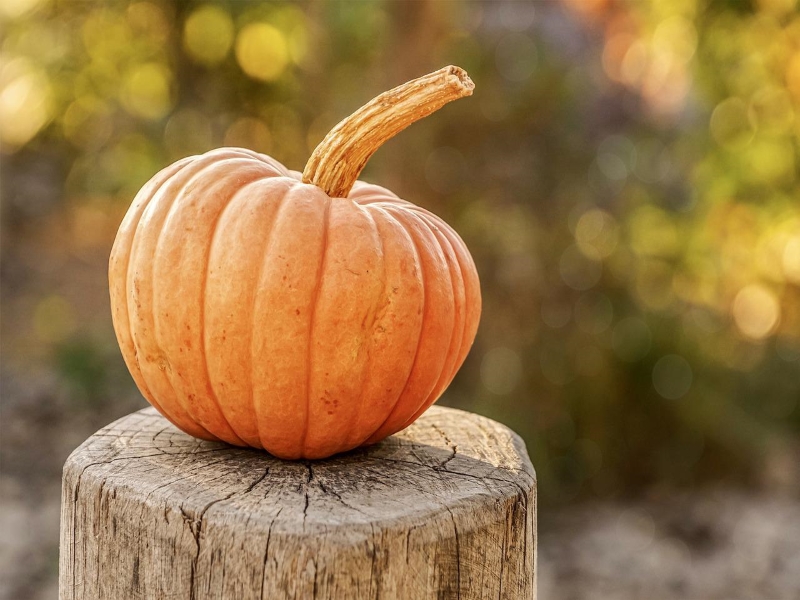
7. Long Island Cheese Pumpkin
These deeply ridged, medium-sized pumpkins can develop in a variety of colors, but they are often paler hues, perhaps with green specks. Long Island Cheese Pumpkin is sweeter and comparable to the New England Cheddar. However, in addition to baking, Long Island Cheese Pumpkin is frequently used for grilling, steaming, and even roasting.

8. Marina di Chioggia
The King of Italian Squashes, Marina di Chioggia is an old Italian heirloom variety that comes from close to Venice. Large, distinctive, turban-shaped fruits weighing 6 to 10 pounds and with a rich, sweet taste, deep yellow-orange flesh are produced on sturdy vines.
The deep yellow-orange, juicy, delicious flesh is of good quality.
This wonderful squash is circular, short, and squat in shape, and it ranges in size from medium to big. The dark green to grey-blue skin is almost entirely covered in sugar warts, which are raised lumps caused by the accumulation of excess sugars in the squash’s skin and flesh. The classic pumpkin has a faint skin, vertical ridging.
The tasty yellow-orange flesh of the fruits gets better in flavor over time while they may be stored for a long time.
When fully grown, the stem at the cap will be tough, rigid, and brown, and the skin will have stiffened to the point where a fingernail cannot ding it. A semi-hollow fibrous cavity surrounded by a thick, dense, and dry yellow-orange flesh with several large, flat, cream-colored seeds.
Marina di Chioggia is nutty-flavored, sweet, and tender when cooked. The popular street meal is still offered by sellers along the canals of Venice, where it is simply sliced, grilled, and salted. It is a common squash in Italy and can be found at markets and farm stands during the season. The bargemen presented the wedge as a whole, grilling it with olive oil.
This pumpkin is well-liked for its meaty and tasty flesh, which also makes it a favorite for gnocchi and ravioli fillings. It tastes great baked or when making excellent pumpkin pies.
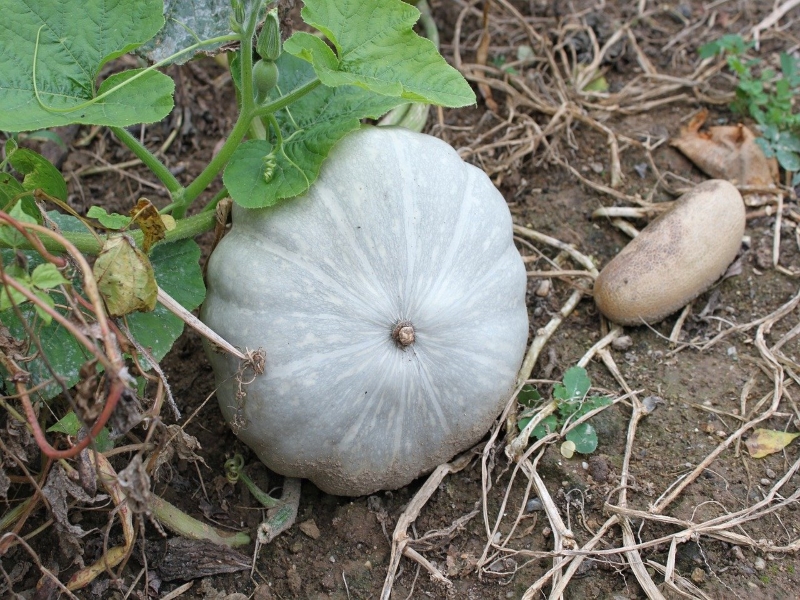
9. Jarrahdale Pumpkin
It is a traditional Cinderella pumpkin because of its thick ribs and steel blue skin tone. This heirloom variety originated in New Zealand, and it bears the name of the town of Jarrahdale where it was first grown. They weigh up to 10 pounds.
Some blue pumpkins include the Kabocha and Kakai (both popular in Japan), the Blue Lakota, which has an oblate spheroid shape, and the pale blue Blue Max.
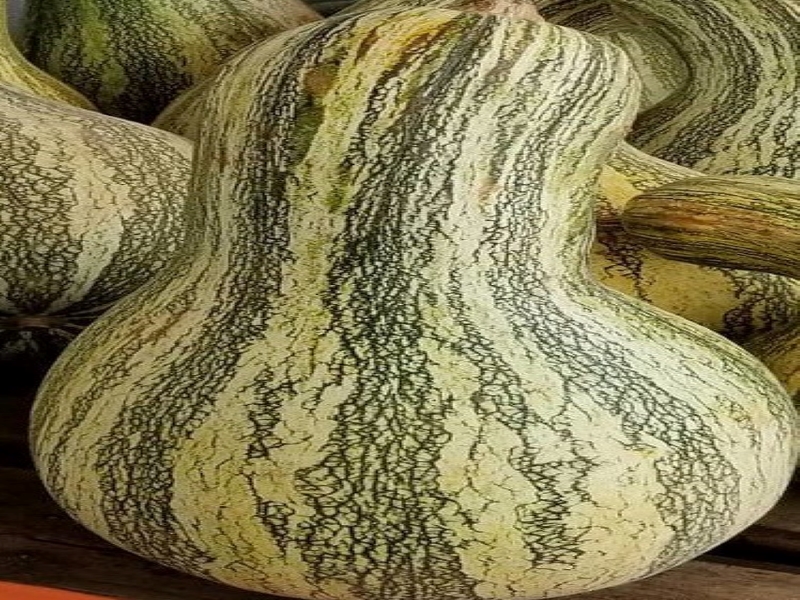
10. Green Striped Cushaw Pumpkin
This pumpkin type has pale orange flesh that is comparable to a cantaloupe flesh, with green and white stripes. It typically takes 110 to 125 days to harvest, and it weighs between 7 and 25 lbs.
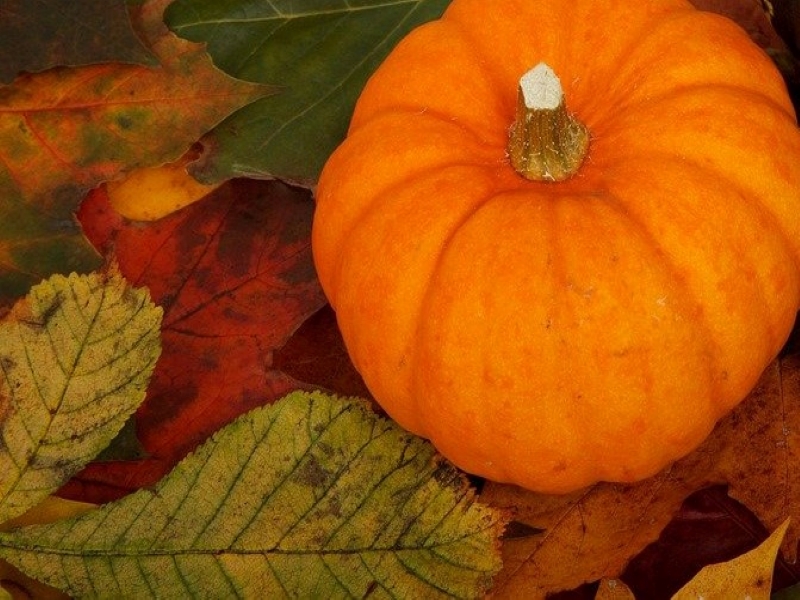
11. Jack-Be Little Pumpkin
This edible, palm-sized mini pumpkin ripens to a more even medium orange color.
These pumpkins are a great option for decorating small rooms or individual table settings, along with other miniature pumpkins like the Baby Boo, Munchkin, or Sweetie Pie.
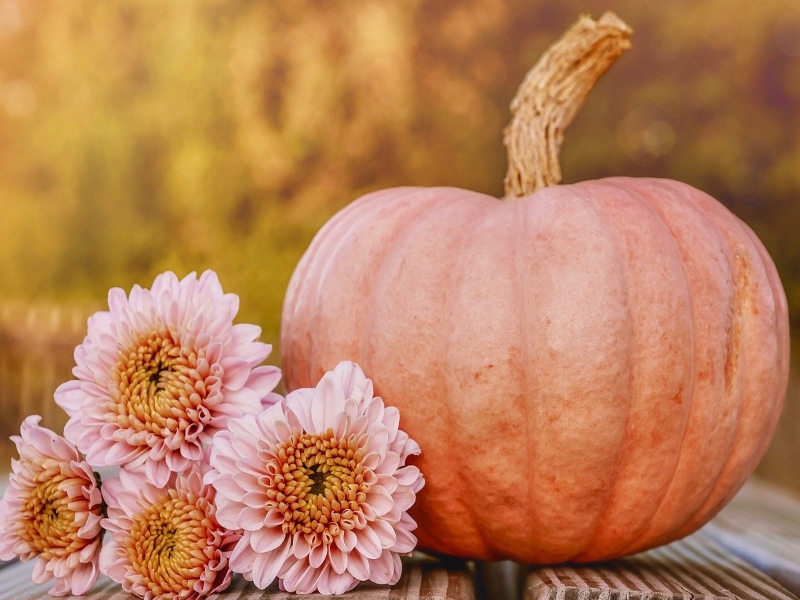
12. New England Cheddar Pumpkin
Their name comes from the fact that these medium-sized pumpkins resemble large cheese wheels. It has a creamier, light orange skin. They work well in baked foods like pie since they have more sugar and are therefore sweeter.
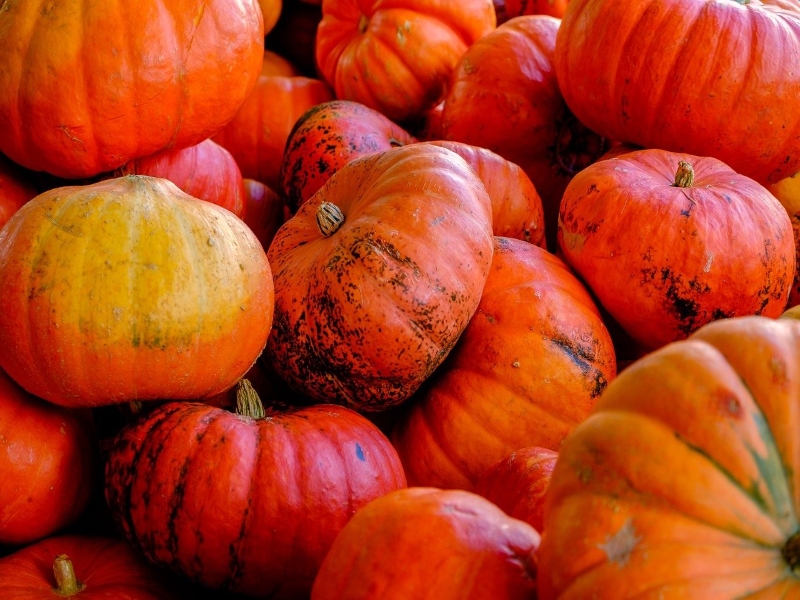
13. Rouge Vif d’Etampes
Famous French seed company Vilmorin identified this traditional heirloom as the most well-liked pumpkin in 1880s Parisian marketplaces. Its name, which means “Vivid red from Etampes”, is a reference to the historic town south of Paris where it was produced for market. Rouge Vif D’Etampes was initially made available to American gardeners by W Atlee Burpee in 1883.
Generally speaking, this rare and distinctive variety of pumpkin is an heirloom that bears the name of a former French town. These lovely pumpkins make beautiful table settings, but they are also excellent for roasting. You can make ornaments out of it, which is fantastic for autumn displays due to its appealing shape and color. This type of pumpkin is the norm for French soup stocks and is more than simply a lovely pumpkin.

14. Atlantic Giant
If you want to win a contest for pumpkin cultivation, you might want to pick from this selection of pumpkins. As suggested by the name, it is a large-sized pumpkin that can weigh between 300 and 500 lbs. Typically, harvesting takes 150 to 160 days.

15. Autumn Gold
It features fiery, bright orange flesh and is a variety that has won awards. This cultivar enjoys popularity in both the cooking and for carving. It can weigh between 10 and 15 lbs. The duration of harvesting is 90 to 100 days.

16. Fairytale
It’s a small type pumpkin. They can be orange or bluish-green, and they nearly always have sharp ridges and seem flattened. They add sweetness to baked products and a creamy texture to soups when cooked and pureed.
At maturity, this species can weigh between 140 and 151 lbs.
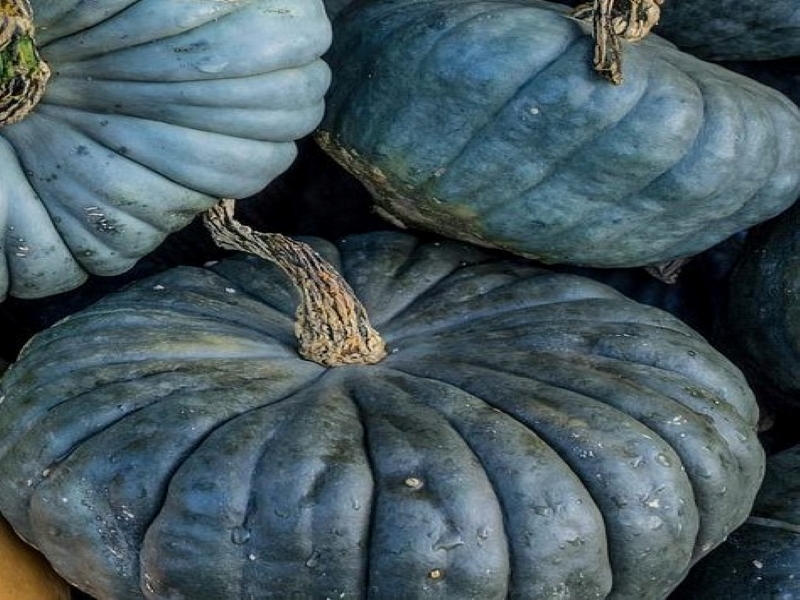
17. Blue Doll Pumpkin
The Blue Doll Pumpkin is a medium-sized hybrid pumpkin variety with deep ribbing and an extraordinary blue color. The fruits of the pumpkins weigh between 15 and 20 pounds each and have an almost square shape.
The pumpkin’s sweet, deep orange flesh makes it a fantastic ingredient for pies, soups, and other fine dining dishes. Appropriate for pies as well as roasting.
Uses Of Pumpkin
For Cooking
Pumpkins can be used in a variety of dishes. The pumpkin’s soft shell, seeds, leaves, and flowers are among its edible components. Pumpkin is a well-liked Thanksgiving and Halloween food in the US and Canada. Sometimes, pumpkin purée is made and frozen.
The pumpkin can be boiled, steamed, or roasted when it is mature. In its native North America, pumpkins are a significant component of the customary autumn harvest and are frequently used in soups and purées in addition to being consumed mashed. It is frequently turned into pumpkin pie, which is a popular Thanksgiving classic in both Canada and the United States. The seeds are frequently roasted and consumed as a snack in China, Canada, Mexico, the United States, and Europe.
Green, young pumpkins can be consumed in the same manner as summer squash or zucchini.
Pumpkin is used in Middle Eastern sweet dishes; one well-known sweet treat is halawa yaqtin.
In a recipe known as kadu ka halwa, pumpkin is prepared with butter, sugar, and spices on the Indian subcontinent.
In Udupi cuisine, pumpkin is used to produce sambar.
The leaves of the pumpkin plant are eaten as a cooked vegetable or added to soups in the Chinese province of Guangxi. With other vegetables, pumpkin is frequently roasted in Australia and New Zealand.
Small pumpkins are used in savory Japanese cuisine like tempura.
Pumpkins are utilized in both cooking and sweets (candied) in Myanmar. The seeds are a well-liked alternative to sunflower seeds.
Small pumpkins with custard inside are steamed and served as dessert in Thailand.
Pumpkins are frequently prepared in soups in Vietnam along with pork or shrimp.
It can be combined with cheeses to make a flavorful ravioli stuffing in Italy. Additionally, both alcoholic and nonalcoholic beverages can be flavored with pumpkin.
Pumpkin Seed Oil
Depending on the thickness of the oil layer, the characteristics of the container, and the hue shift of the observer’s eyes, pumpkin seed oil, a heavy oil extracted from roasted pumpkin seeds, appears red or green. Due to its strong flavor, pumpkin seed oil is typically combined with other oils when used in cooking or as a salad dressing. Fatty acids like oleic acid and alpha-linolenic acid are found in pumpkin seed oil.
Halloween
For the Halloween season, pumpkins are frequently carved into jack-o’-lantern-style decorative lanterns.
Long before it became a symbol of Halloween, the carved pumpkin was initially connected to the harvest season in general in the United States. A lit jack-o’-lantern was suggested in a 1900 essay on Thanksgiving entertainment as a part of the festivities that inspire children and families to work together to create their own jack-o’-lanterns.
Other Uses
Native Americans have utilized pumpkins as traditional medicine to treat urinary and intestinal worms, and American doctors accepted this Native American therapy as an anthelmintic for the expulsion of worms in the early nineteenth century.
C. peo seeds were found in Germany and southeast Europe, and were also utilized as traditional medicines for benign prostatic hyperplasia and irritable bladder.
Traditional Chinese medicine also utilized C. moschata seeds for the treatment of tape worms and the parasitic disease schistosomiasis.
Pumpkin seed meal (C. moschata) is a valuable source of nutrients for poultry feed, improving the quality of the eggs produced for human consumption.
Storing Pumpkins
Although they are most abundant in September and October, pumpkins are frequently sold in supermarkets through November. Pumpkins can be stored for up to 90 days, however after 30 days they might start to rot. They do well in places that are dry and cold. They might only endure a few weeks once heat and humidity are present. Use your pumpkin within five days of slicing it open if you’re cooking with it.
One of the most popular varieties in stores and the ideal for baking are sugar pumpkins. Other excellent baking options are Cinderella, Long Island Cheese, and New England Pie. Watch out for sensitive spots when cooking, carving, or decorating with your pumpkin. Pick a pumpkin that still has its stem every time.

